
Welcome to sacramentosnakes.com! I am David, a snake enthusiast living in Sacramento, CA. Many people don't know that Sacramento is in fact full of snakes! You just need to know where to find them - they can often be shy and elusive. Some California snake species are more common outside of the city limits, in different parts of Sacramento County CA, but many types of snakes are indeed common in the more urban parts of Sacramento. This guide is meant to help educate you about the beautiful snakes of Sacramento, and to help you identify the most common snakes of Sacramento, as well as the venomous snakes of Sacramento that you should learn to recognize and avoid. If you want more detail, click here for my complete list of ALL snake species in Sacramento. Remember the following:
- Most snakes of Sacramento are harmless and don't want to encounter you
- Venomous snakes exist but are uncommon in Sacramento, California
- Snakes eat rats and mice and are a valuable part of the California ecosystem
- Never kill a snake - if you leave a snake alone, it will leave you alone.
Common Snake Species in Sacramento
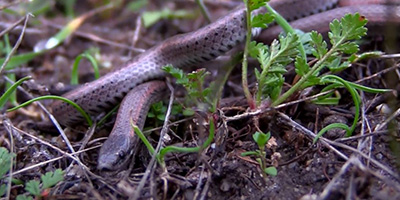 Sharp-Tailed Snake:
These dull red and brown snakes are rather elusive, spending most of their time buried under decomposing debris to stay warm. There are in fact two such species of sharp-tailed snakes in California, and it is the common variant that resides in the Sacramento area. The forest species is much less common. Rarely over a foot long, these harmless snakes feed on slugs, their eggs, and small salamanders. Since they enjoy warming in leaf piles, they are often found in wooded areas. Non-venomous and too small to pose a threat to people or their pets, these snakes are best left to live their slug-eating lives.
Sharp-Tailed Snake:
These dull red and brown snakes are rather elusive, spending most of their time buried under decomposing debris to stay warm. There are in fact two such species of sharp-tailed snakes in California, and it is the common variant that resides in the Sacramento area. The forest species is much less common. Rarely over a foot long, these harmless snakes feed on slugs, their eggs, and small salamanders. Since they enjoy warming in leaf piles, they are often found in wooded areas. Non-venomous and too small to pose a threat to people or their pets, these snakes are best left to live their slug-eating lives.
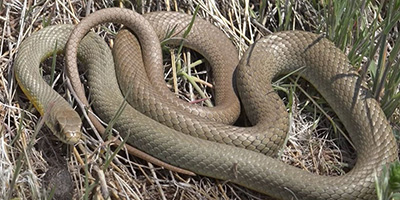 Western Racer:
These relatively large, speedy snakes come in a variety of colors, but a variation of brown or green are common. They enjoy sunning and can be found across northern California. Not very picky, western racers will eat pretty much anything smaller than them, including their own species. More common prey includes animal eggs, large insects, birds, and other reptiles, obviously. Rodents are also potential prey. They generally prefer arid environments despite the variety of their diet. As a non-venomous species, they pose no threat to people and generally don’t settle around them unless there are leaves to be had, which makes them more common around people than the snakes themselves might appreciate despite their preference to be under the leaves and not kicked up while within them.
Western Racer:
These relatively large, speedy snakes come in a variety of colors, but a variation of brown or green are common. They enjoy sunning and can be found across northern California. Not very picky, western racers will eat pretty much anything smaller than them, including their own species. More common prey includes animal eggs, large insects, birds, and other reptiles, obviously. Rodents are also potential prey. They generally prefer arid environments despite the variety of their diet. As a non-venomous species, they pose no threat to people and generally don’t settle around them unless there are leaves to be had, which makes them more common around people than the snakes themselves might appreciate despite their preference to be under the leaves and not kicked up while within them.
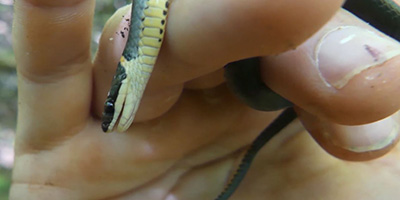 Ring-Necked Snake:
Several subspecies of this snake call California home, and the coral-bellied variant can be found in the Sacramento area. Black with red bellies, these snakes don’t get much over a foot in length. As a smaller snake, they mostly eat small amphibians, slugs, insects, and the like. Due to their preferred diet, they tend to live in moist environments like lush meadows and woodlands. Harmless to people, these beautiful slug-eaters are best left alone as they do important work for gardeners across the state. Fortunately, these are really the only venomous snake that can be found in the Sacramento area in any quantity. The sheer size of the state of California means random snakes from around may make a home anywhere, but by and large, these rattlers are the only dangerous snakes in the region.
Ring-Necked Snake:
Several subspecies of this snake call California home, and the coral-bellied variant can be found in the Sacramento area. Black with red bellies, these snakes don’t get much over a foot in length. As a smaller snake, they mostly eat small amphibians, slugs, insects, and the like. Due to their preferred diet, they tend to live in moist environments like lush meadows and woodlands. Harmless to people, these beautiful slug-eaters are best left alone as they do important work for gardeners across the state. Fortunately, these are really the only venomous snake that can be found in the Sacramento area in any quantity. The sheer size of the state of California means random snakes from around may make a home anywhere, but by and large, these rattlers are the only dangerous snakes in the region.
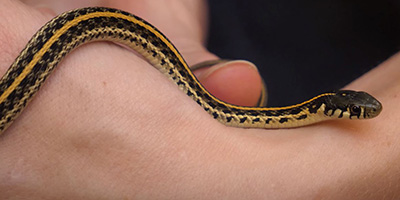 Garter Snakes:
Several species of garter snakes can be found across California, and some of them are around Sacramento. Generally black or brown with stripes that lend them to resembling a piece of garden hose, these harmless snakes eat rodents and other small critters. Valley and mountain garter snakes can both be found in the Sacramento area, feeding on rodents and other small animals as they live their lives. The giant garter snake also lives in the area. Regardless of name or coloration, garter snakes overall are relatively similar in diet and demeanor. They are harmless to people and their pets, feed on rodents and small creatures, and are non-venomous.
Garter Snakes:
Several species of garter snakes can be found across California, and some of them are around Sacramento. Generally black or brown with stripes that lend them to resembling a piece of garden hose, these harmless snakes eat rodents and other small critters. Valley and mountain garter snakes can both be found in the Sacramento area, feeding on rodents and other small animals as they live their lives. The giant garter snake also lives in the area. Regardless of name or coloration, garter snakes overall are relatively similar in diet and demeanor. They are harmless to people and their pets, feed on rodents and small creatures, and are non-venomous.
Venomous Snake Species in Sacramento
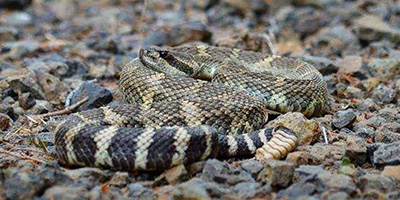 Northern Pacific Rattlesnake:
Several species of rattlesnake reside within California, and the Northern Pacific rattler is one that can be found in the Sacramento region. Active in the day or night, depending on heat, they will live most anywhere except the desert. Perhaps due to their diet, they have an unfortunate tendency to be found near homes. They come in various shades of brown with a spotted pattern and are usually between one and three feet long. Attracted to heat sources like other pit vipers, they’ll eat nearly anything they can swallow, though it’s worth noting that adult ground squirrels are immune to their venom. They are very venomous and thus, obviously, dangerous to those who are not an aforementioned squirrel.
Northern Pacific Rattlesnake:
Several species of rattlesnake reside within California, and the Northern Pacific rattler is one that can be found in the Sacramento region. Active in the day or night, depending on heat, they will live most anywhere except the desert. Perhaps due to their diet, they have an unfortunate tendency to be found near homes. They come in various shades of brown with a spotted pattern and are usually between one and three feet long. Attracted to heat sources like other pit vipers, they’ll eat nearly anything they can swallow, though it’s worth noting that adult ground squirrels are immune to their venom. They are very venomous and thus, obviously, dangerous to those who are not an aforementioned squirrel.
If you're unsure, you can email me a photo of the snake at info@sacramentosnakes.com and I will email you back with the snake's species. If you found a snake skin, read my Found a Skin? page, and you can email me a photo of the skin, and I'll identify the snake for you. If you need professional Sacramento snake removal help, click my Get Help page, or see the below website sponsor I found, who provides that service.
Remember, the term is not poisonous snakes of Sacramento, it's venomous snakes of Sacramento. Poison is generally something you eat, and venom is injected into you. That said, dangerous snakes are very rare in Sacramento. The few venomous snakes of Sacramento County are rarely seen. But they are commonly misidentified, so learn about all the snake species of Sacramento in order to correctly identify them. These snakes are usually also found in the surrounding towns of Elk Grove, Folsom, Rancho Cordova, Citrus Heights, Carmichael, Arden-Arcade, Fair Oaks, North Highlands, Galt, Antelope, Orangevale, Rio Linda, Florin, Gold River, Rosemont, Isleton, Rancho Murieta, Walnut Grove, Foothill Farms, McClellan Park, Wilton, Laguna, La Riviera, Vineyard, Herald, Courtland, Franklin, Lemon Hills, Hood, Clay, and the surrounding areas.
Read our article about:
Do Snakes Have Ears? Can They Hear?
sacramentosnakes.com domain and hosting costs made possible by the generous support of this sponsor:
